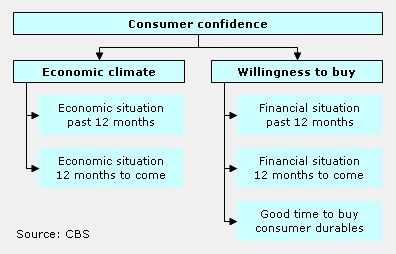consumer spending marginally up, consumer confidence hardly changes

According to figures released by Statistics Netherlands today, household spending on goods and services was 0.6 percent up in November 2014 from November 2013. For the second month in a row consumption increased marginally. Dutch consumers spent more on durable goods. Consumer confidence remained fairly stable in January relative to December.
Consumption figures have been adjusted for price changes and differences in the shopping-day pattern.
Spending on household appliances, home furnishing articles and bicycles up
Household spending on durable goods was 3.4 percent higher than twelve months previously. Consumers spent more on household appliances and home furnishing articles. Just as in October, they also bought more bicycles than one year previously.
More bicycles were sold at the end of the year, because in 2014 an arrangement to the effect that employers make a financial contribution, if employees purchase a bicycle to travel between home and work, was abolished.
Dutch consumers spent 2.7 percent more on food, drinks and tobacco products than last year. Spending on other goods (including natural gas and motor fuels) was down by 4.3 percent. Household spending on services, accounting for more than half of domestic consumption, grew by 0.6 percent.
Circumstances for consumption in December about the same as in November
On balance, circumstances for Dutch household consumption remained stable in January relative to December. Manufacturers were more negative about future employment in their sector, but the contraction of the labour force on an annual basis, was smaller than in the previous month. Dutch consumers were also less pessimistic about future unemployment. By means of six indicators, the Household Consumption Radar shows whether circumstances for Dutch household consumption have become more or less favourable.
Consumer confidence hardly changes
The mood among consumers improved marginally in January compared to December. Consumer confidence was - 6 in January, versus - 7 in December. Consumers’ opinions about the economic climate were somewhat less negative; their willingness-to-buy remained virtually unchanged.
With - 6, consumer confidence in January is above its long-term average over the past two decades (- 8). Consumer confidence reached the highest level ever in April 2000 (27) and reached its lowest level in February 2013 (- 44).
Opinion about economic climate improves somewhat
The component indicator Economic climate was - 2, versus - 4 in December, because consumers were more positive about the future economic situation. The component indicator willingness-to-buy was - 9, versus - 10 in December.
Consumer confidence

Today, Statistics Netherlands also publishes data on investment.
More figures can be found in dossier Business cycle.
For more information on economic indicators, see the Economic Monitor.